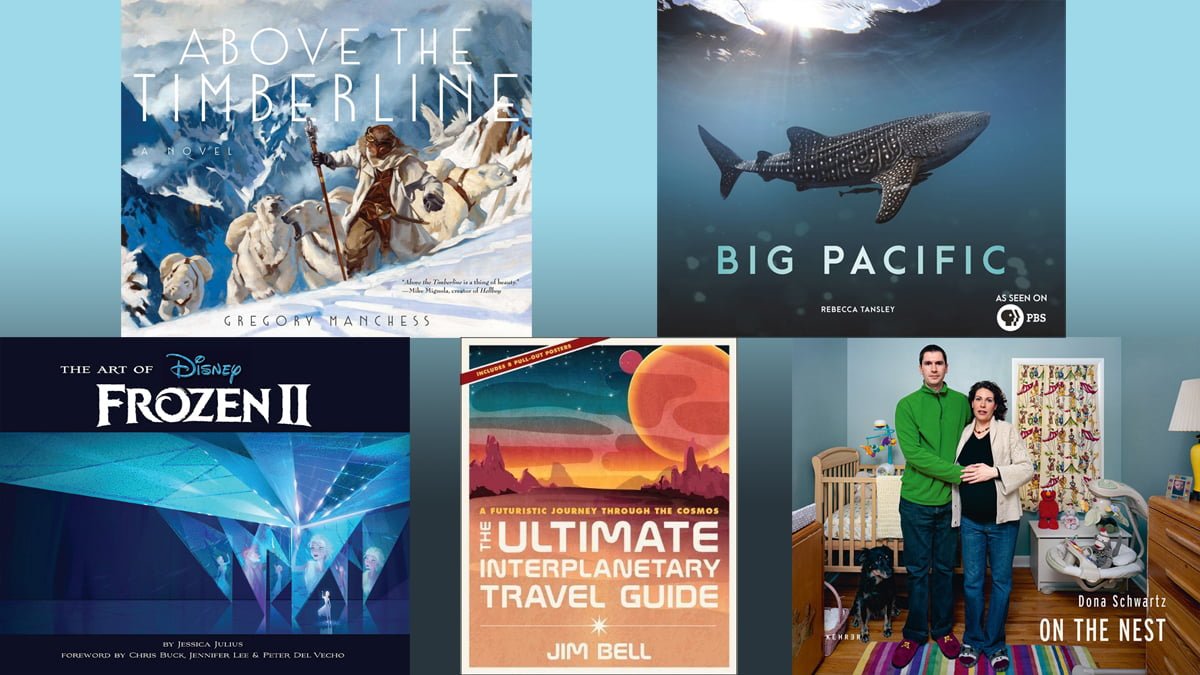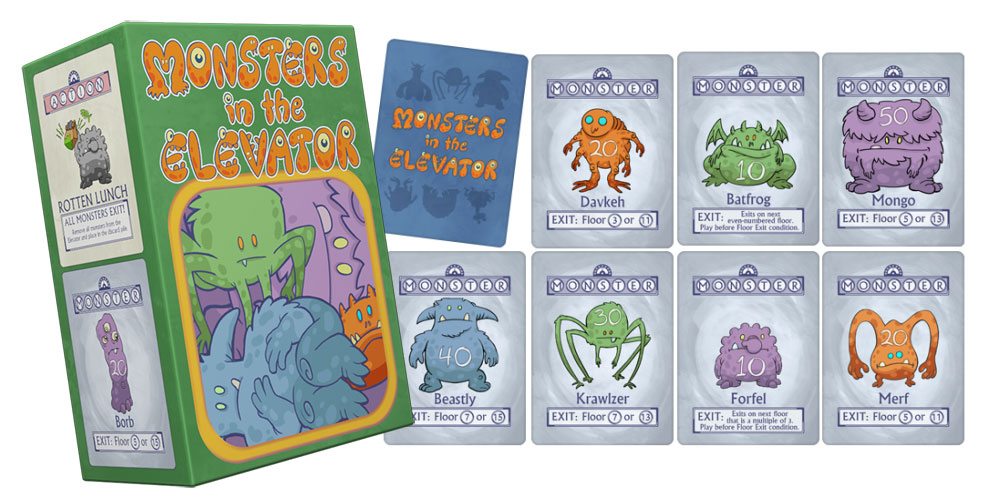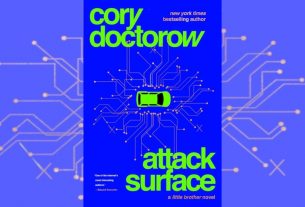The thing about coffee table books—if people still call them that—is that they’re ideal for having on display on a coffee table, but you can only have one or two there at a time. It doesn’t really work to have an entire stack of them. We have a bookshelf in our living room where we keep oversized books, and we’re constantly needing to prune because, well, these are big books we’re talking about.
So: today’s column is all about these gorgeous, oversized books—not all new, but all fun to look at. You probably don’t need to get all of them (at least not all at once) but they’re definitely fun to peruse!
The Art of Frozen 2 by Jessica Julius
We took our family to see Frozen 2 recently, and the next day my youngest daughter was already asking why I didn’t have a copy of The Art of Frozen 2 on the shelf. (I have a predilection for “Art of” books, so we have several of them covering some of our favorite films.) So I was delighted when this volume showed up in my review stack shortly thereafter.
The book focuses on the design of the characters—both old and new—and the environment, which plays a big role in the movie. For the existing characters, it was a lot of fun to see how they carried over elements and color palettes from the first film but made the characters a little older and more mature (except for Olaf, maybe!), and of course it’s always interesting to read about the new characters. I won’t say much more about the environmental design, but if you’ve seen the film you know that there are some spectacular effects that come into play, and I enjoyed learning more about the thought that went into the way things looked, as well as some of the challenges the animation teams faced in making their visions a reality on screen.
Although the book doesn’t spell out the plotline, there’s certainly enough discussion about the movie that I would consider the book a spoiler, so I recommend waiting until you’ve seen the movie (which is a lot of fun—see Matt’s post about it) before cracking this one open.
On the Nest by Dona Schwartz
This oversized book is a collection of photographs in two sections: the first shows people who are about to become parents, and the second shows people who are now empty-nesters. The “On the Nest” photographs show the parents (mostly couples, though there are some single moms as well) usually in the room they’ve prepared for the child they’re expecting, and gives their names and the due date (or expected adoption date, in some cases). Some are also accompanied by interview questions: How did you decide to have a baby now? What are you most excited about? What are you the most anxious about?
For the empty nesters, the parents are also shown in what appears to be their child’s room, but this time along with their names it lists how long ago their last child moved out. Some are recent, a matter of weeks or months, and some are several years. There are interview questions here as well: What do you enjoy most about being an empty nester? What do you miss the most about having your kids at home?
While the photographs aren’t always flattering, it’s a fascinating look at the beginning of parenthood, and the close of a chapter (though I suppose you never stop being a parent entirely). It’s fun to look at the wide range of baby rooms, from having a crib in the corner of the parents’ room to elaborate themed nurseries, though I did feel a little concern for the couple who were expecting in 2 weeks who had a totally empty room—perhaps in a new home?—because, hey, that’s coming up fast. For the empty nesters, I was intrigued by how long it took before the kids’ room was reclaimed: some looked like they had been untouched, and some showed almost no traces of having been a kids’ room.
Dona Schwartz and her husband are themselves in the empty nesters category, though fairly recent as they still have a daughter in college, so her interest in these parents has a personal touch to them. I think whether you’re just starting your journey as a parent or you’ve transitioned to the empty nest, you’ll find these images and stories worth pondering.
Big Pacific by Rebecca Tansley
This book is a companion to the PBS documentary series about the Pacific Ocean and the multitude of life that lives in, around, and above it. It’s full of gorgeous photos and wild stories about creatures in its water, on its many islands, and even some of the people who live on its shores. A couple things I hadn’t heard of before were the Bobbit worm, which grows up to 20 feet long, burrows in the sea floor, and looks like the creature on the cover of Terror Below. I also learned about the Peppered moray eel, which actually leaves the water and hunts for crabs on land. The ocean is a spectacular, mesmerizing place, and this book is a great way to experience it, and I’ve enjoyed sharing it with my kids, too. We may need to watch the series now, too!
Above the Timberline by Gregory Manchess
This book is like an illustrated novel: it looks like it’ll be a book of paintings, perhaps, but it’s actually a story. It’s set in the far future after a second ice age leads to a cataclysm where Earth’s magnetic poles shift, wreaking havoc on the tectonic plates. Galen Singleton is an explorer who’s convinced there’s a mysterious city filled with secrets from before the shift; he was closing in when his aircraft crashed in the far north, and has been missing for months, managing only to send a hawk messenger with a cryptic message. Galen’s teenage son, Wesley, resents his father for being absent, but has decided to mount a rescue effort—to bring back his father, yes, but partly to prove himself better.
The story has a sort of steampunk feel to it, though rather than Victorian England, it’s set in the year 3518: some technologies have been rediscovered, and new ones have been invented. Manchess’ painted illustrations are evocative and fantastic (in both senses of the word). He has painted for the National Geographic, Smithsonian, and more, and the images have a photographic quality even when the things in them are unreal.
The story itself is made up of different types of “records,” including Galen’s and Wes’s journals, as well as some transcripts from ship recorders. I did have a little trouble at times keeping track of the timeline, because the story isn’t always told in chronological order, and Wes is jumping around through his dad’s journals. There was at least one instance where a few particular months in Galen’s journal were repeated but with different entries, and that seemed unintentional, but it worked out all right. The story is kind of a pulp adventure story: double-crosses and mysterious strangers, high-speed chases and some derring-do; it’s not necessarily a story that I would have read on its own, but paired with these images, it was a fun ride.
The Ultimate Interplanetary Travel Guide by Jim Bell
If you’re looking to really get away for a vacation, this book is essential reading. Dr. Jim Bell, president of the Planetary Society, introduces the planets and many moons (along with some other features like the asteroid belt) in the form of a travel guide published in 2218, after humanity has left Earth and established colonies throughout the solar system. He notes must-see features, warns you about things you should know before you go (like extreme temperatures or acid rain), and provides a historical timeline of discoveries (though, of course, the ones that take place beyond 2019 are fictional). The guide is illustrated with both imaginary and real images, from travel posters to satellite photos.
Although there is some humor in the premise, it also has a serious purpose, as Bell explains in his author’s note. He believes that what will drive further space exploration is partly “our spirit of wanderlust,” which is fed by the tourism industry. Depicting the various celestial bodies as not just objects to study but actual places to visit is a way to build that excitement, and challenge readers to imagine a future where this type of travel could happen.
Disclosure: I received copies of these books for review.
My Current Stack
Aside from the books already mentioned above, I’ve been reading a bunch of comics lately and a novel—strangely, several of them have birds on the cover, so you may see some of those as a future Stack Overflow. It’s time for another big culling session because my stacks are still overflowing, so I’m trying to get at least some more of them read to help me decide which books I can let go…









